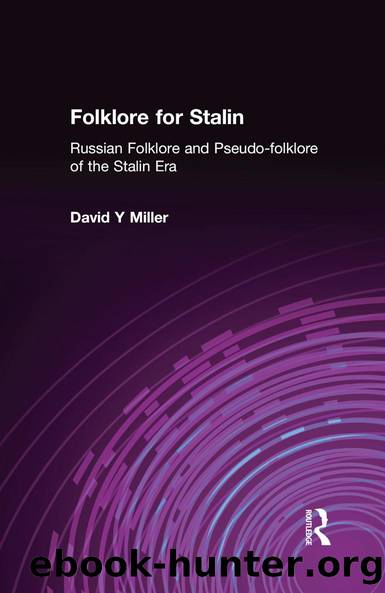Folklore for Stalin: Russian Folklore and Pseudo-folklore of the Stalin Era by Frank J. Miller

Author:Frank J. Miller [Miller, Frank J.]
Language: eng
Format: epub
Tags: History
ISBN: 9781000161236
Google: gJ_5DwAAQBAJ
Barnesnoble:
Goodreads: 3497219
Publisher: Routledge
Published: 1990-01-01T00:00:00+00:00
Later, in police headquarters, the wife is beaten so severely that she lies senseless for several hours before she can go home. Korguevâs negative portrayal of the Serbs and the English at police headquarters and at the prison camp in Siberia is calculated to encourage hatred toward foreigners. The sympathy of the prison guards for the revolutionaries makes the point that people throughout the country supported the Revolution.
The heroes of the Soviet tales are many. Both Kovalev and Sorokovikov depict Leninâs and Stalinâs struggle against tsarist oppression. Stalin, the younger hero, rescues Lenin from tsarist prisons and later drives the White enemy from the country. Chkalov surmounts the obstacles set for him by the Tsar of the North and flies to America, while Russian aviatrixes explore their own country. Kovalevâs polar explorers (cheliuskintsy) subdue the Tsar of the Sea and perform scientific tasks for the benefit of the people. The heroes of Bespalikov, Kovalev, and Sorokovikov protect their country from enemy attack. The dauntlessness of collective farm leaders is recognized in Bespalikovâs âThe Scarlet Flowerâ and Kovalevâs âIvan the Unfortunate.â Ordinary people, searchers for truth, demonstrate that the Revolution had brought happiness to everyone. Chapaev, the hero of several prewar tales, appears in the war tales of Sychev and leads the Russians to victory over the invading Germans. The past Russian military heroes Platov, Suvorov, and Nekrasov are resurrected in the tales of Sychev and Gospodarev.
Authors of Soviet tales, like the composers of noviny, described contemporary life in a pseudofolklore genre. One of the most prolific authors of new tales, Kovalev, used the narrative ceremonialism of the traditional folktale most consistently in his new tales. Formulas, magic objects and helpers, various three-fold repetitions, as well as numerous folklore motifs recur constantly, but the language of Kovalevâs new tales is an artificial mixture of colloquial and literary styles. By combining numerous dialecticisms and incorrect grammatical constructions with bookish words and the syntactical phraseology of the literary language, Kovalev created his own linguistic style, neither that of the traditional folktale nor that of the literary tale. There are also many examples of bookish speech in the Soviet tales of Sorokovikov, but they lack the many dialecticisms of Kovalevâs tales. Nevertheless, combinations of the literary language with the colloquial and at times archaic language of the traditional folktale are distracting stylistic inconsistencies in Sorokovikovâs new works. They have little narrative ceremonialism, lack the expanded introductory and concluding formulas of Kovalevâs tales, and give a much lesser role to magical objects.
Magical objects are also scarce in the tales of other narrators. Bespalikovâs heroes use living water to revive their brother; Pavel Zhukov, the chairman of the kolkhoz, is saved by the Order of Lenin which turns into a red flower on his grave. Konashkovâs collective farmers, Marâia, Fedor, and Aleksei, are led to Moscow by a rolling ball of yarn, and Korguevâs Chapaev is protected from enemy bullets by a magic ring effective only on land. In Buzaevâs tale âChapaiâ, an old Kirghiz gives the hero a horse which can carry him away from all harm.
Download
This site does not store any files on its server. We only index and link to content provided by other sites. Please contact the content providers to delete copyright contents if any and email us, we'll remove relevant links or contents immediately.
Spell It Out by David Crystal(35852)
Life for Me Ain't Been No Crystal Stair by Susan Sheehan(35539)
Cecilia; Or, Memoirs of an Heiress — Volume 1 by Fanny Burney(32073)
Cecilia; Or, Memoirs of an Heiress — Volume 3 by Fanny Burney(31468)
Cecilia; Or, Memoirs of an Heiress — Volume 2 by Fanny Burney(31418)
The Great Music City by Andrea Baker(30795)
Professional Troublemaker by Luvvie Ajayi Jones(29425)
We're Going to Need More Wine by Gabrielle Union(18641)
Twilight of the Idols With the Antichrist and Ecce Homo by Friedrich Nietzsche(18305)
The Secret History by Donna Tartt(18208)
All the Missing Girls by Megan Miranda(14784)
Cat's cradle by Kurt Vonnegut(14775)
Pimp by Iceberg Slim(13797)
Bombshells: Glamour Girls of a Lifetime by Sullivan Steve(13697)
Fifty Shades Freed by E L James(12923)
Talking to Strangers by Malcolm Gladwell(12888)
Norse Mythology by Gaiman Neil(12858)
The Social Justice Warrior Handbook by Lisa De Pasquale(11957)
Underground: A Human History of the Worlds Beneath Our Feet by Will Hunt(11846)
